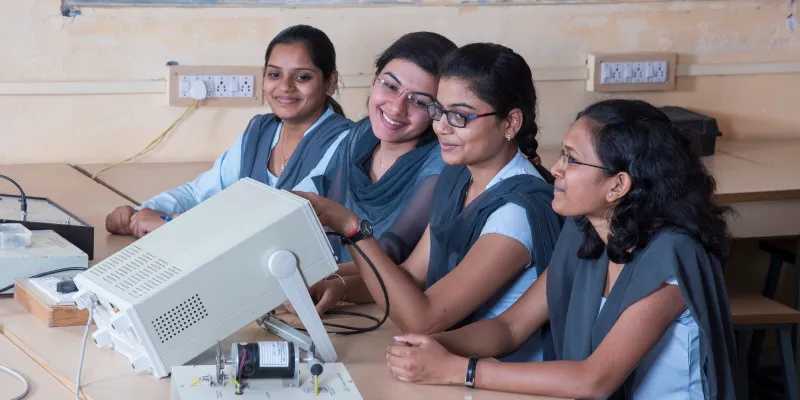Independence Day 2019: Improving women’s higher education is key to India becoming a $10T economy
Ahead of Independence day, Mohandas Pai and Nisha Holla focus on how India’s women must be empowered to contribute to the nation’s growth. It is critical that India leverages this economic multiplier to its GDP.
The National Fertility and Health Survey-4 shows India’s fertility rates have dramatically dropped to 2.18, below replacement rate, leading to demographic distress. Demographics are changing across the socio-religious spectrum and are strongly correlated with women’s education and literacy. Now, we look at women’s progress in higher education to further understand this change.

Higher education statistics published by AISHE, MHRD (Table 1) from 2011-12 to 2017-18 show an increasing trend. The total number of males enrolled increased by 30.3 lakh, 18.7 percent, in six years, while the number of women enrolled increased by 44.3 lakh, a whopping 34 percent rise. The compound annual growth rate (CAGR) for total enrollment is 3.87 percent, with males at 2.9 percent and females at 5 percent. The percentage of women rose from 44.6 percent in 2011-12 to 47.6 percent in 2017-18. More women are pursuing higher education now than ever before.

Table 1: Year-wise enrollment in higher education in India (data from AISHE, MHRD)
Extrapolating the data out to 2030 (Fig 1) indicates the number of women pursuing higher education might soon exceed men. The year 2024-25 could see a normalisation between genders, and 2029-30 could see as much as 53 percent enrollment of women, a dramatic shift. Many countries around the world have undergone this. In the United States, according to official statistics, 56 percent of undergraduates are women. India is following this trend.

Fig 1: Enrollment of women vs men in higher education, projected to 2029-30 (data from AISHE, MHRD)
The total Gross Enrollment Ratio (GER) in age 18-23 is steadily increasing from 20.8 in 2011-12 to 25.8 in 2017-18 (Table 2). Male enrollment increased from GER of 22.1 to 26.3, a 19 percent increase. Female enrollment rose even faster, with a GER under 20 to 25.4, a significant jump of 30 percent. The GER between genders is normalising, again indicating that more women are turning towards higher education to improve their livelihood.

Table 2: Gross Enrollment Ratio in higher education in India (data from AISHE, MHRD)
These trends show a silent revolution over the last decade, with significant implications on fertility rates and the economy. It would seem that as more women are turning towards higher education and correspondingly better employment opportunities, they are delaying childbirth and having fewer children. Higher education is one of the contributors to the levelling off of population growth.
With India’s 29 states having diverse economic conditions, variance in state-wise GER is huge. Table 3(a) contains GER of representative states in North and South India for 2011-12 and 2017-18. On average, North Indian states have much lower GER compared to South, and the divergence is increasing. GER also correlates with development - Bihar’s GER moved nominally by 0.5 in six years and also trails in development metrics.

Table 3(a): State-wise GER of representative states in North and South India (data from AISHE, MHRD)

Table 3(b): Population-weighted averages in the North and South (data from AISHE, MHRD)
The population-weighted averages of representative North and South Indian states are computed in Table 3(b). Significant observations are:
- Both the North and South GER have progressed significantly in the last decade. North Indian states have progressed by 4.88 points and South Indian states by 6.33 points from 2011-12 to 2017-18.
- The difference between the Northern and Southern states of India is striking. On average, the GER of South Indian states is ahead of the North Indian states by 13.37 points in 2017-18.
- Women are progressing faster than men. In North India, the average female GER jumped 5.91 points from 2011-12 to 2017-18, whereas the male GER moved 4.03 points. In South India, the female GER jumped 6.67 points whereas the male GER moved 4.49 points.
The status of women has dramatically increased in India. At the time of Independence, policymakers did not focus on educating women. As a result, household income and India’s GDP did not grow as much as it could have. Contrast this with China - with the establishment of the People’s Republic of China in 1949, Chairman Mao famously said “Women hold up half the sky”, and instituted strict policies to educate women. The result is evident today in women’s workforce participation, and contribution to China’s GDP and outstanding rise as a Top 2 economy. With India’s women pursuing higher education in larger numbers, they must be empowered to contribute to the nation’s growth. It is opportune for India to leverage this economic multiplier to its GDP as it sets course to the $10 trillion mark.
Improving workforce participation
The need of the hour today is to provide the educated population with quality employment prospects. These must include incentives for the participation and traction of women in the workforce. Many women in India are primary caregivers of their children and other family members. Employment policies must take these constraints into account so women can have the flexibility to work around their schedules. Otherwise, well-educated women will have no option but to drop out of the workforce, which is a loss for everyone - from the individual to her family to the nation.
Fertility survey data indicates there will be fewer young people 20 years from now. This will result in India’s workforce shrinking rapidly while supporting an ageing population. Instead, if more women are incentivised to work, they will contribute to society and the GDP for a long time, especially given that Indian lifespans and general wellbeing are also increasing.
Policy can also examine which fields women are pursuing more and focus on retention there. AISHE data shows that for the first time in 2017-18 enrolment in MBBS had more women, 50.3 percent, than men. If workforce participation for women doctors is improved through policy, this could transform India’s healthcare system.
The next pertinent question is ‘are women in India overtaking men?’ and how to deal with this. In South India, educational institutions are resorting to interesting ways of handling the inversion. For example, some pre-university colleges in Bangalore are applying a higher cut-off percentage for women applicants. While this might not be the fairest way, we certainly see a possibility of a ceiling - say 60 percent - imposed on women’s enrolment.
The data from the AISHE and NFHS surveys indicate that the best investment India can make towards economic prosperity and societal progress is in higher education and employment prospects of women.
(Disclaimer: This article has been published earlier and is being reproduced here. The views and opinions expressed in this article are those of the author and do not necessarily reflect the views of YourStory.)
(Edited by Teja Lele Desai)



1551777893165.png?fm=png&auto=format&h=100&w=100&crop=entropy&fit=crop)




